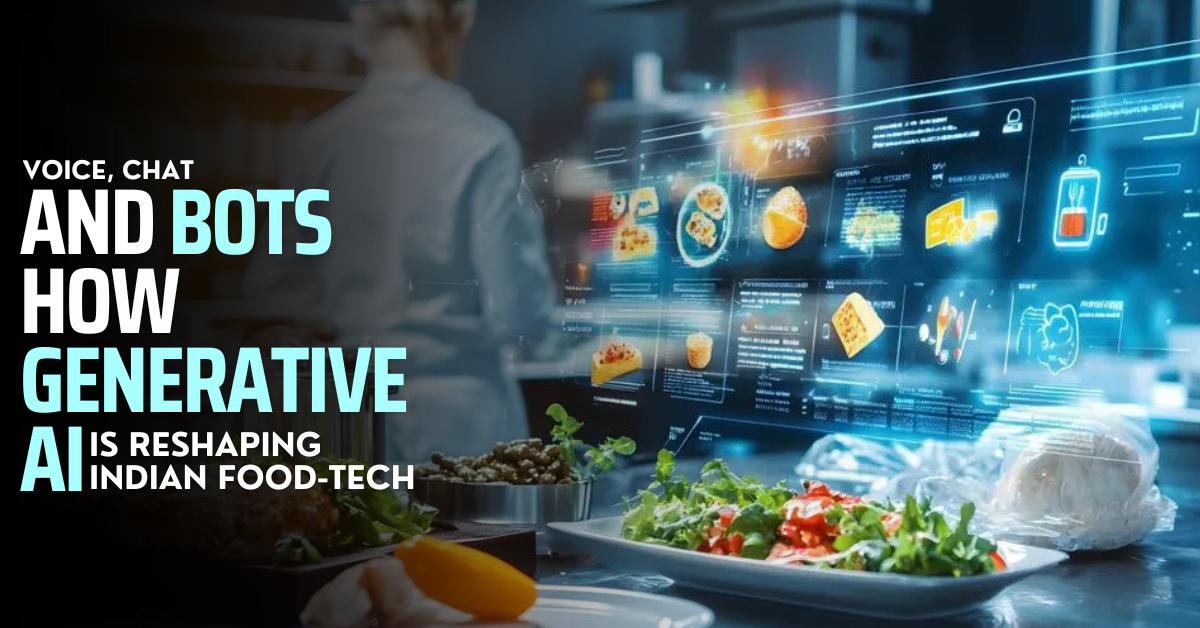Introduction: A New Era for India’s Food Industry
The Indian food-tech industry has witnessed a massive transformation in the past decade — from restaurant aggregators and cloud kitchens to 10-minute grocery deliveries. But now, a fresh wave of innovation is brewing, powered by Generative AI.
From voice ordering in vernacular languages to AI-powered recipe bots and automated customer chats, Generative AI is revolutionizing how Indians discover, cook, order, and interact with food services.
This blog explores how Gen AI is shaping the future of India’s food-tech — quietly but rapidly.
What is Generative AI and Why It Matters in Food-Tech
Generative AI refers to AI models that can generate content — including text, images, audio, video, and even code — by learning patterns from massive data sets.
In food-tech, it enables:
Conversational interfaces for customer support and ordering
Personalized recommendations based on taste and dietary needs
Automated menu generation for restaurants
Interactive cooking assistants in multiple languages
Predictive demand modeling for food delivery platforms
And most importantly, it makes food-tech more human, responsive, and intelligent — at scale.
Voice is the New Menu: Vernacular AI in Action
India is a multilingual country, and Gen AI is helping bridge the gap between food platforms and Bharat users through voice-first experiences.
Use Cases:
Ordering food using voice assistants in Hindi, Tamil, Bengali, etc.
AI-based kitchen devices (like smart microwaves or mixers) that guide users with cooking instructions in local languages
Voice-enabled grocery shopping bots for elderly and non-English speakers
Players like Zomato, Swiggy, and BigBasket are actively investing in voice tech to increase inclusivity and ease.
Chatbots: From FAQs to Full-Service Support
AI-powered chatbots have moved beyond answering basic questions. In 2025, food-tech chatbots in India now:
Take orders with real-time menu navigation
Suggest recipes or meal kits based on leftover ingredients
Handle refunds, cancellations, and loyalty rewards
Offer dietary advice or caloric info instantly
And the best part? These bots operate in regional languages, making customer experience seamless for everyone — from a college student in Pune to a homemaker in Patna.
Menu Magic: How AI Is Helping Restaurants Stay Fresh
Generative AI is also changing how restaurants build and manage their menus:
| Traditional Way | AI-Powered Menu Management |
|---|---|
| Static seasonal updates | Dynamic menus based on local trends & supply chain |
| Human-generated item descriptions | Auto-written content with nutrition insights |
| Guess-based pricing | AI-based price optimization using demand data |
| One-size-fits-all combos | Custom combos based on customer behavior |
Startups like Posist and Petpooja are now integrating Gen AI tools that automate A/B testing of menus, pricing, and offers — with real-time insights.
Hyper-Personalization: AI Knows What You Crave
Imagine opening a food app and being greeted with:
“Hi Ramesh, hungry after your gym? Here are your high-protein meal options.”
“Hello Priya, it’s Friday evening — would you like to reorder your favorite Biryani from last week?”
That’s Generative AI in action, using:
Purchase history + time of day + mood detection (via text/voice cues)
Dietary tags (vegan, gluten-free, Jain, etc.)
Local weather and festivals to suggest perfect meals
AI now personalizes not just the interface, but the intention — delivering food that fits the moment.
Content Creation: Food Brands Level Up with AI
AI is not just serving consumers — it’s helping food brands scale their content.
Auto-generating Instagram captions, blog posts, and recipe cards
AI-driven voiceovers for regional food ads
Product description writing for grocery and kitchenware listings
Content creators and food influencers are also using AI tools like ChatGPT, Midjourney, and ElevenLabs to script, visualize, and narrate multilingual cooking content at lightning speed.
Kitchen Automation: The Rise of Smart Cooking
Restaurants and home kitchens are getting smarter with:
AI-powered cooking assistants that guide with recipes based on ingredients
Voice-controlled appliances (e.g., “preheat oven to 180 degrees”)
Robot chefs that mix, stir, and cook with minimal human effort
These tools are being developed by Indian startups and global innovators alike, making intelligent cooking more affordable and accessible.
Challenges Still on the Table
While Gen AI is unlocking exciting possibilities, the Indian food-tech sector also faces challenges:
Data privacy and ethical AI usage (especially with voice and behavior tracking)
Bias in recommendations that may ignore dietary diversity
Language accuracy and emotional nuance in non-English bots
Adoption by small eateries that lack tech literacy
Solving these will require collaboration between tech, food service, and policy players to ensure safe, fair, and inclusive AI.
Future Trends: What to Watch in 2025 and Beyond
Here’s what’s coming next:
Regional recipe discovery bots for rural cooking traditions
AI-powered food waste reducers in supply chains
Emotional intelligence in bots to detect hunger cues, stress, etc.
Voice-first grocery checkout using smart speakers and wearables
Augmented reality (AR) menus powered by generative AI for immersive ordering
The future of food-tech is not just digital — it’s deeply sensory, cultural, and intelligent.
Conclusion: From Clicks to Conversations
Generative AI is not replacing human taste — it’s enhancing the entire food experience in India. By making ordering easier, cooking smarter, and discovery more personal, it’s changing how we think, talk, and interact with food.
For food-tech founders, marketers, chefs, and consumers — this is the era where voice, chat, and bots blend into one powerful recipe for growth.
Read
Transforming Customer Experience with Indian AI Voice & Chatbots







